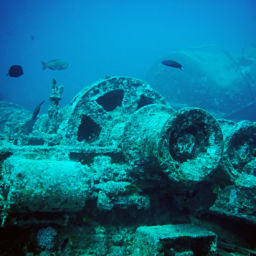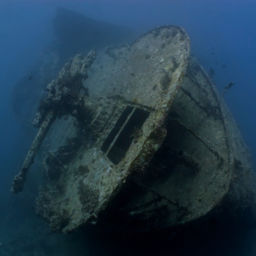All wrecks decay over time, including the SS Thistlegorm. Salt water and local bacteria are the main culprits, which is why cold, freshwater wrecks stay pristine longer. However, the introduction of oxygen from divers’ expelled air speeds up the process. This is the nature of wreck diving — wrecks disappear. In a very few years, we’ll have no more intact wooden wrecks from the age of sail; they will simply have decayed. That finality is part of the lure of wreck diving: our dive sites are not permanent, and if we dive the same wreck year after year, we can see it decay in front of our very eyes.
Sometimes, however, storms aggravate the process artificially, by sweeping an area and disturbing a wreck. The deeper the wreck, the less this is a problem. Fishing boats dredge the wreck for fish, damaging it in the process, and dive boats moor on the wreck in damaging ways.
The latter is a major problem for the SS Thistlegorm. Due to its popularity, several dive boats moor on it every day, most days of the year, and not all of them do so sustainably. Many wrecks, including the Thistlegorm, have mooring points, typically buoys for smaller boats, and anchor points on the wreck itself for larger boats. All of these have been placed by experienced divers to ensure that the wreck is damaged as little as possible when boats tie off on them. If no such mooring points exist, or they are crowded, boats are urged to tie off with soft ropes, rather than anchor chains, as these can wreak havoc on the wreck.
Saving the SS Thistlegorm
The problem is, of course, that most people, even scuba divers, are unaware of these considerations, and unaware of whether the dive operator they’re diving with follows recommendations or not. But now, a group of dedicated divers called Saving the SS Thistlegorm has taken to social media, in particular Facebook, to document the state of protection on the Thistlegorm, or as they call it, “the old lady.” By posting picture documentation of moorings on the wreck and calling out dive boats by name, they seek to praise others who are working on saving the SS Thistlegorm and name and shame those who aren’t. They also document both their own efforts and others to secure increased protection of the wreck. With the knowledge of who is and isn’t practicing safe and sustainable methods around the wreck, it’s hoped that divers will choose their liveaboard or dive tour operator accordingly.
And it does seem to be working, as a post from November 2, 2015 documented. Therein the Chamber of Diving and Watersports (CDWS) requested that dive boats not use metal wires to moor the boat. Boast also aren’t allowed to moor in weak or unstable areas of the hull.
Of course, poor and damaging practices on wrecks are not isolated to the SS Thistlegorm. But this wreck is at an elevated risk due to its popularity. Perhaps as the community involvement does seem to be working, it can serve as inspiration for divers concerned about wrecks in their own waters.






